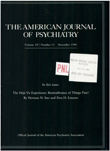Tardive dyskinesia in bipolar affective disorder: aging, cognitive dysfunction, course of illness, and exposure to neuroleptics and lithium
Abstract
Cognitive function, course of illness, and medication history were assessed in 42 bipolar patients evaluated for the presence of involuntary movements. Among the 25 patients 55 years old or older, the 16 with involuntary movements were not distinguished from the nine without involuntary movements by past or current exposure to neuroleptics, anticholinergics, or carbamazepine, but they showed poorer cognitive function, had fewer major depressive episodes, and had received briefer exposure to lithium. The association between involuntary movements and cognitive dysfunction parallels that found in schizophrenia, suggesting that similar neurological processes may contribute to vulnerability to involuntary movements in the major functional psychoses.
Access content
To read the fulltext, please use one of the options below to sign in or purchase access.- Personal login
- Institutional Login
- Sign in via OpenAthens
- Register for access
-
Please login/register if you wish to pair your device and check access availability.
Not a subscriber?
PsychiatryOnline subscription options offer access to the DSM-5 library, books, journals, CME, and patient resources. This all-in-one virtual library provides psychiatrists and mental health professionals with key resources for diagnosis, treatment, research, and professional development.
Need more help? PsychiatryOnline Customer Service may be reached by emailing [email protected] or by calling 800-368-5777 (in the U.S.) or 703-907-7322 (outside the U.S.).



